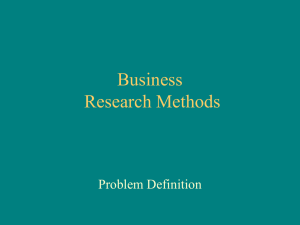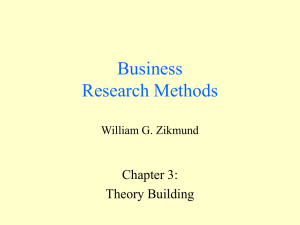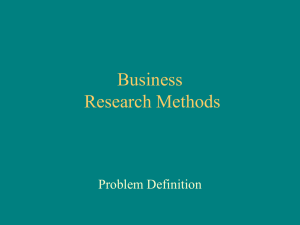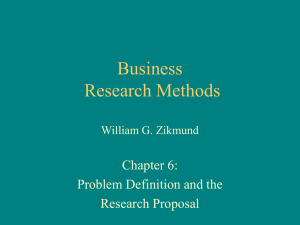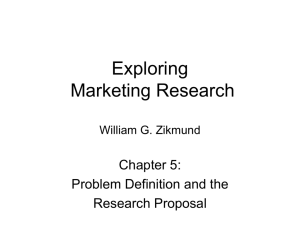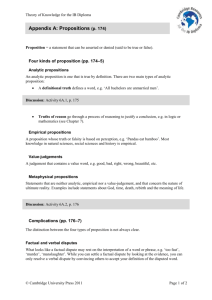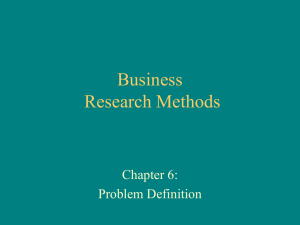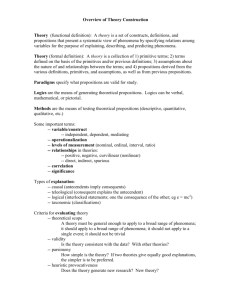Business Research Methods William G. Zikmund
advertisement
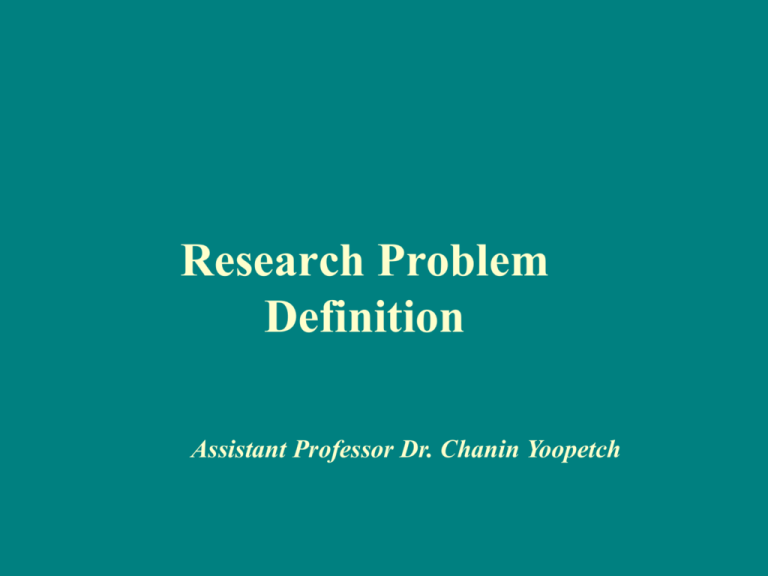
Research Problem Definition Assistant Professor Dr. Chanin Yoopetch Problem discovery Problem Discovery and Definition Sampling Selection of exploratory research technique Secondary (historical) data Experience survey Probability Pilot study Case study Data Gathering Data Processing and Analysis Problem definition (statement of research objectives) Experiment Laboratory Conclusions and Report Survey Field Interview Nonprobability Collection of data (fieldwork) Editing and coding data Data processing Selection of basic research method Research Design Selection of exploratory research technique Questionnaire Observation Secondary Data Study Interpretation of findings Report Uncertainty Influences the Type of Research CAUSAL OR DESCRIPTIVE COMPLETELY CERTAIN ABSOLUTE AMBIGUITY EXPLORATORY Problem Discovery and Definition • • • • First step Problem, opportunity, or monitor operations Discovery before definition Problem means management problem “The formulation of the problem is often more essential than its solution.” Albert Einstein Problem Definition • The indication of a specific business decision area that will be clarified by answering some research questions. Defining Problem Results in Clear Cut Research Objectives Symptom Detection Analysis of the Situation Problem Definition Statement of Research Objectives Exploratory Research (Optional) The Process of Problem Definition Ascertain the decision maker’s objectives Determine unit of analysis Understand background of the problem Determine relevant variables Isolate/identify the problem, not the symptoms State research questions and objectives Ascertain the Decision Maker’s Objectives • Decision makers’ objectives • Managerial goals expressed in measurable terms. 9 The Iceberg Principle • The principle indicating that the dangerous part of many business problems is neither visible to nor understood by managers. Understand the Background of the Problem • Exercising judgment • Situation analysis - The informal gathering of background information to familiarize researchers or managers with the decision area. 11 Isolate and Identify the Problems, Not the Symptoms • Symptoms can be confusing 12 Symptoms Can Be Confusing Twenty-year-old neighborhood swimming association: • Membership has been declining for years. • New water park -residents prefer the expensive water park???? • Demographic changes: Children have grown up Organization Twenty-year-old neighborhood swimming association in a major city. Symptoms Membership has been declining for years. New water park with wave pool and water slides moved into town a few years ago. Problem Definition Based on Symptom True Problem Neighborhood residents prefer the expensive water park and have negative image of swimming pool. Demographic changes: Children in this 20year-old neighborhood have grown up. Older residents no longer swim anywhere. Determine the Unit of Analysis • Individuals, households, organizations, etc. • In many studies, the family rather than the individual is the appropriate unit of analysis. 15 Determine the Relevant Variable • Anything that may assume different numerical values 16 Types of Variables • • • • Categorical Continuous Dependent Independent Hypothesis • An unproven proposition • A possible solution to a problem • Guess State the research questions and research objectives 19 If you do not know where you are going, any road will take you there. Broad research objectives Statement of business problem Exploratory research (optional) Specific Objective 1 Specific Objective 2 Specific Objective 3 Research Design Results The Process of Problem Definition Ascertain the decision maker’s objectives Determine unit of analysis Understand background of the problem Determine relevant variables Isolate/identify the problem, not the symptoms State research questions and objectives Theory Building and Observation Methods Theories Theories are nets cast to catch what we call “the world”: to rationalize, to explain, and to master it. We endeavor to make the mesh ever finer and finer. Karl R. Popper Two Purposes Of Theory • Prediction • Understanding Theory • A coherent set of general propositions used as principles of explanation of the apparent relationships of certain observed phenomena. Concept (or Construct) • A generalized idea about a class of objects, attributes, occurrences, or processes that has been given a name • Building blocks that abstract reality • “leadership,” “productivity,” and “morale” • “gross national product,” “asset,” and “inflation” Vegetation Fruit Banana Reality Increasingly more abstract A Ladder Of Abstraction For Concepts Scientific Business Researchers Operate at Two Levels • Abstract level – concepts – propositions • Empirical level – variables – hypotheses Definitions • Abstract level -In theory development, the level of knowledge expressing a concept that exists only as an idea or a quality apart from an object. • Empirical level -Level of knowledge reflecting that which is verifiable by experience or observation. Theories Propositions Concepts Observation of objects and events (reality ) Increasingly more abstract Theory Building A Process Of Increasing Abstraction Concepts are Abstractions of Reality Abstract Level Empirical Level CONCEPTS OBSERVATION OF OBJECTS AND EVENTS (REALITY) Scientific Method The use of a set of prescribed procedures for establishing and connecting theoretical statements about events and for predicting events yet unknown. Abstract Level • Concepts abstract reality. • Propositions are statements concerned with the relationships among concepts. Proposition at Abstract Level Concept A Concept B (Reinforcement) (Habits) Hypothesis at Empirical Level Dollar bonus for sales volume over quota Always makes four sales calls a day • A hypothesis is a proposition that is empirically testable. It is an empirical statement concerned with the relationship among variables. • A variable is anything that may assume different numerical values. Deductive Reasoning • The logical process of deriving a conclusion from a known premise or something known to be true. – We know that all managers are human beings. – If we also know that John Smith is a manager, – then we can deduce that John Smith is a human being. Inductive Reasoning • The logical process of establishing a general proposition on the basis of observation of particular facts. – All managers that have ever been seen are human beings; – therefore all managers are human beings. Falsificationist • You cannot prove the theory that it is correct, but you can disprove it. The Scientific Method: An Overview Assess relevant existing knowledge Acquire empirical data Formulate concepts & Propositions Analyze & evaluate data Statement of Hypotheses Design research Provide explanationstate new problem Scientific Observation Is Systematic “YOU SEE, BUT YOU DO NOT OBSERVE.” Sherlock Holmes What Can Be Observed? • • • • • • Physical actions Verbal behavior Expressive behavior Spatial relations and locations Temporal patterns Verbal and pictorial records What Can Be Observed Phenomena Example Human behavior or physical Shoppers movement action pattern in a store Verbal behavior Statements made by airline travelers who wait in line Expressive behavior Facial expressions, tone of voice, and other form of body language What Can Be Observed Phenomena Example Spatial relations and locations How close visitors at an art museum stand to paintings Temporal patterns How long fast-food customers wait for their order to be served Physical objects What brand name items are stored in consumers’ pantries Verbal and Pictorial Records Bar codes on product packages Categories of Observation • • • • Human versus mechanical Visible versus hidden Direct Contrived (artificial environment) Observation of Human Behavior Benefits • Communication with respondent is not necessary • Data without distortions due to self-report (e.g.: without social desirability) Bias • No need to rely on respondents memory • Nonverbal behavior data may be obtained Observation of Human Behavior Benefits • Certain data may be obtained more quickly • Environmental conditions may be recorded • May be combined with survey to provide supplemental evidence Observation of Human Behavior Limitations • • • • • • Cognitive phenomena cannot be observed Interpretation of data may be a problem Not all activity can be recorded Only short periods can be observed Observer bias possible Possible invasion of privacy Observation of Physical Objects • Physical-trace evidence • Wear and tear of a book indicates how often it has been read Scientifically Contrived Observation • The creation of an artificial environment to test a hypothesis Content Analysis • Obtains data by observing and analyzing the content of advertisements, letters, articles, etc. • Deals with the study of the message itself • Measures the extent of emphasis or omission
